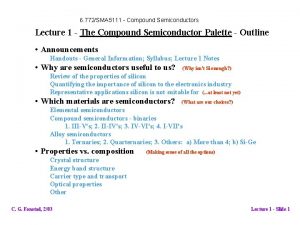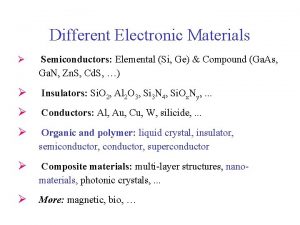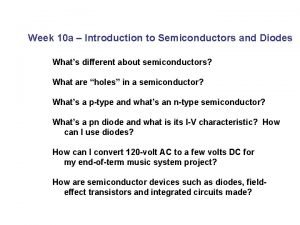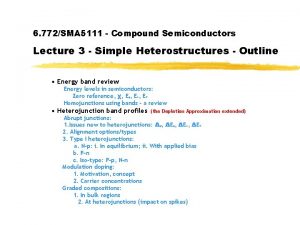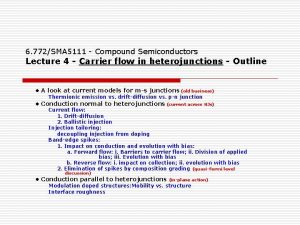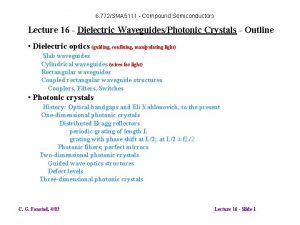6 772SMA 5111 Compound Semiconductors Lecture 3 Simple







- Slides: 7

6. 772/SMA 5111 - Compound Semiconductors Lecture 3 - Simple Heterostructures - Outline • Energy band review Energy levels in semiconductors: Zero reference, χ, Eg, Ec, Ev Homojunctions using bands - a review • Heterojunction band profiles (the Depletion Approximation extended) Abrupt junctions: 1. Issues new to heterojunctions: Δχ, ΔEg, ΔEc, ΔEv 2. Alignment options/types 3. Type I heterojunctions: a. N-p: i. In equilibrium; ii. With applied bias b. P-n c. Iso-type: P-p, N-n Modulation doping: 1. Motivation, concept 2. Carrier concentrations Graded compositions: 1. In bulk regions 2. At heterojunctions (impact on spikes)

Energy band edge picture - review • Band edge energies The band edge energies relative to the vacuum reference level and to each other are a property of the semiconductor Electron affinity , χ: Conduction band edge to vacuum ref. Energy gap, Eg: Valence band edge to conduction band edge • Fermi level Depends additionally on the doping level no= Nc exp[-q(Ec-Ef)/k. T] and thus Ec- Ef = (k. T/q) ln (Nc/no) and/or po = Nv exp[-q(Ef-Ec)/k. T] and thus Ef-Ec= (k. T/q) ln (Nv/po) Work function, Φ: Fermi level to vacuum ref.

Homojunctions - band picture, depletion approximation • Band picture a. Isolated n- and p-type: i. Have same vacuum ref. , ii. Fermi levels differ iii. Both materials neutral

Homojunctions - band picture, depletion approximation • Band picture, cont. b. Electrically connected: i. Charge shifts between sides ii. Fermi levels shift until equal iii. Vacuum ref. is now -qΦ(x) where Φ(x) = (q/e)∫∫ρr(x) dx dx iv. Depletion approximation is a good estimate of ρ(x)

Homojunctions - band picture, depletion approximation • Band picture a. Isolated N- and p-type: (taking an N-p junction as the example) Similar to homojunction except that now the two materials have different electron affinities, energy gaps, dielectric constants, and effective masses.

Homojunctions - band picture, depletion approximation • Band picture, cont. b. Electrically connected: i. Charge shifts between sides ii. Fermi levels shift until equal iii. Vacuum ref. is now -qΦ(x) where Φ(x) = (q/e)∫∫ρ(x) dx dx iv. Ec(x) is -qΦ(x) -χ(x) and Ev(x) = -qΦ(x) - [χ(x) +Eg(x)]

Homojunctions - band picture, depletion approximation • Band picture, cont. c. Useful Observations: i. The final electrostatic potential profile, Φ(x), is primarily a consequence of the doping levels. ii. The band-edge profiles, Ec(x) and Ev(x), are additionally a consequence of the electron affinity and energy gap profiles, χ(x) and Eg(x), respectively. iii. In an abrupt heterojunction there are frequently discontinuities in the conduction and valence band edges at the junction.
 Elemental and compound semiconductors
Elemental and compound semiconductors Elemental and compound semiconductors
Elemental and compound semiconductors Simple compound complex and compound-complex sentences quiz
Simple compound complex and compound-complex sentences quiz Simple compound complex quiz
Simple compound complex quiz 01:640:244 lecture notes - lecture 15: plat, idah, farad
01:640:244 lecture notes - lecture 15: plat, idah, farad Introduction to semiconductors
Introduction to semiconductors Direct and indirect band gap semiconductors
Direct and indirect band gap semiconductors Semiconductor technology roadmap
Semiconductor technology roadmap
